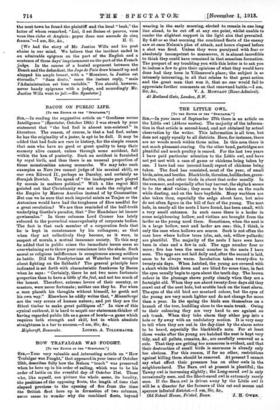THE LITTLE OWL.
[To THE EDITOR OF THE eel-EL-Tiro:4..]
Sin,—In your issue of September 27th there is an article on the Little owl (Athene noctua). The majority of the informa- tion in that article is second-band, and not obtained by actual observation by the writer. This information is all true, but does not apply equally to all districts. Here, for instance, there are no woods much within three miles. In this area there is not much pheasant-rearing. On the other hand, partridges are plentiful and much poultry is reared. For the last two years I have paid particular attention to the Little owl, and have not yet met with a case of game or chickens being taken by one. I have bad one (second-band) report of chickens being taken. The food has consisted, most of the year, of small birds, mice, and beetles. Blackbirds, thrushes, bullfinches, green- finches, tits, and other birds in about that order usually. In the summer, and especially after hay harvest, the skylark seems to be the thief victim ; they seem to be taken on the roads while dusting, and on the bare hayfields. Many warblers are also taken then, especially the sedge about here, but mice do not often figure in the bill of fare of the young. The nest hole, in nearly all the nests I have found, has been small, with a very small entrance. In such cases there is a larder in some neighbouring hollow, and victims are brought from the larder as the young need them. Sometimes, when the nest is in a large hollow, nest and larder are one: this, I think, is only the case when hollows are scarce. Such is not often the case here where hollow trees (elm, ash, oak, willow pollards) are plentiful. The majority of the nests I have seen have been in elms and a few in oak. The eggs number four or more ; five has been the usual number in the nests I have seen. The eggs are not laid daily and, after the second is laid, seem to be always warm. Incubation takes twenty-five to twenty-six days. When hatched, the young are covered with a short white thick down and are blind for some time, in fact the eyes usually begin to open about the tenth day. The brown colour in the plumage shows pretty clearly when they are a fortnight old. When they are about twenty-four days old they crawl out of the nest hole, but scuttle back on the least alarm. The eyes of the old bird are mustard colour, but the eyes of the young are very much lighter and do not change for more than a year. In the spring the birds sun themselves on a branch of the tree, huddling close to the main trunk. Owing to their colouring they are very bard to see against an oak trunk. When they take alarm they either pop into a hole or fly- away with an undulatory motion. It is very easy to tell when they are out in the day-time by the alarm notes to be heard, especially the blackbird's note. For at least three weeks after the young are hatched the nest is kept very tidy, and all pellets, remains, &c., are carefully removed as a rule. That they are getting too numerous is evident, and that their destruction of small birds is enormous is already only too obvious. For this reason, if for no other, restrictions against killing them should be removed. At present I cannot say what effect their presence has on other owls in the neighbourhood. The Barn owl at present is plentiful; the Tawny owl is increasing slightly; the Long-eared owl is only occasionally seen, and the Short-eared owl is extremely rarely seen. If the Barn owl is driven away by the Little owl it will be a disaster for the farmers of this rat and mouse and sparrow infested district.—I am, Sir, &c., Old School House, Fested, Essex. J. H. Ow.






























































 Previous page
Previous page